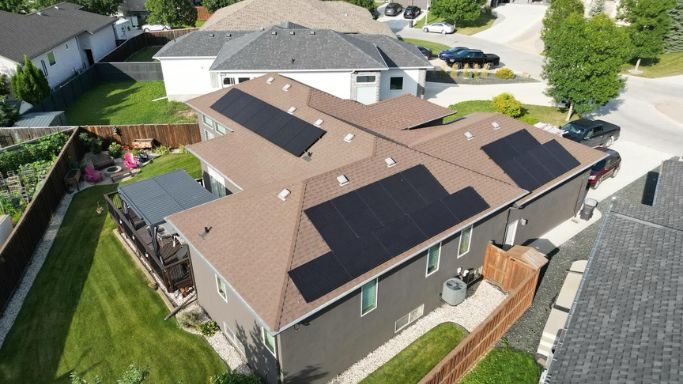According to Natural Resources Canada, solar power has grown 10% in the Prairie provinces over the last five years, driven by improved photovoltaic efficiency and decreasing costs from solar companies Winnipeg. Recent news highlights growing interest in energy independence, as Manitoba aims to meet federal targets for alternative energy by 2035.
However, all installations must adhere to the Canadian Electrical Code (CEC) and local building codes. The two primary requisites are the Building Permit and the Electrical Permit, which involve assessments of the proposal, structural integrity, and electrical connection to the grid.
Manitoba Hydro requires a Utility Connection Permit for any solar system tied to its grid. As of 2023, it continues to offer rebates, incentivizing clean energy adoption. But along with various applications comes full permit compliance. So, what permits should Winnipeg homeowners prepare for a stress-free transition? Let’s find out.

Why Solar Power is Growing Now?
Solar energy production is determined by Global Horizontal Irradiance (GHI), a measure of the total energy received per square meter. Winnipeg experiences an annual average GHI of 4.35 kWh/m²/day, comparable to Southern Ontario regions and outperforms many other Canadian cities. One of the drivers behind the growth is the availability of economic incentives and programs, such as Manitoba Hydro’s Net Metering Program, in partnership with Efficiency Manitoba.- The program allows solar systems with a capacity of up to 200 kW to participate, facilitating adoption for small residential systems and larger commercial solar installations that lower utility bills while increasing monthly savings.
- Monocrystalline silicon panels and PERC (Passivated Emitter and Rear Cell) have contributed to increased energy conversion and lower operating costs.
- The average efficiency has risen from 15% in the early 2000s to over 20% today. Homeowners and businesses produce more electricity from the same amount of sunlight than fossil fuels before.
The Permits Required
Development Permit
This verifies that the structure is situated on the property in compliance with the zoning bylaw and the regulations of other City departments. However, this is not necessary for photovoltaic installations if the solar power system is either:- Installed on a building and mounted at least 8 feet above the ground or;
- Mounted on the ground.
Building Permit
This is required for all structural work, including installing solar panels on a roof or the ground. The City of Winnipeg’s Department of Planning, Property, and Development mandates that a Manitoba Licensed Professional Engineer certify that the truss system is adequate to support the new load. Applications for wall- or roof-mounted PV systems include these:- Dimensiones site plan
- Completed Required Professional Designer’s Certificate (commercial) or Professional Designer’s Certificate for Housing, as applicable
- Declaration Form for Development Permit Exemption (Photovoltaic)
- Owner Statement for Housing (not required owner is the applicant)
- Letter of Owner Authorization (commercial) or Owner Statement if professionals are involved
For Roof-Mounted
- One legible PDF copy of building plans, including panels and mounting equipment specifications.
- The plans are drawn to a scale of 1:250 or 1/8” = 1’, and the engineer’s signature and seal should be dated within one year of the submission.
- If digital plans are unavailable, two paper copies (drawn to scale) are submitted instead, except for smaller plans (11″ x 17″), which only require a single copy.
- These plans provide details on wind loads, snow loads, and other environmental factors outlined in the National Building Code of Canada.
For Ground-Mounted
- A detailed site plan is necessary. Include the array layout, wiring paths, and foundation details supporting the panels.
- A completed Required Professional Designers Certificate (for commercial projects) or a Professional Designer’s Certificate for Housing, depending on the project type.
- Declaration Form for Development Permit Exemption (Photovoltaic).
- Site-specific considerations, such as the soil condition and proximity to neighbouring properties, are also addressed.
- Applicants are to submit a Status of Title for the land; it should be no more than 30 days old and confirm the legal ownership of the property.
- Foundation type and layout
- Mounting system specifications, including weight
- Design loads (dead, live, wind, and snow).
Electrical Permit
This is issued through Manitoba Hydro, which oversees compliance with national and provincial electrical safety standards. The application should detail the system’s electrical configuration, including the photovoltaic (PV) module specifications, inverter capacity, and wiring layout. Regarding safety, Manitoba Hydro requires:- System grounding
- Overcurrent protection devices
- Anti-islanding
Description of Work
The permit application must include a brief description of the work, which should specify the following details:- The type of system being installed, such as micro-inverter, string inverter with optimizer, or string inverter.
- The total capacity of the installation process (measured in kW).
- The PV system’s DC source circuit voltage (e.g., string voltage) or the AC output voltage for micro-inverters.
Housing Installations Limitations
The voltage for source or output circuits in PV installations on residential homes and their accessory structures must not exceed 600 V DC, as per WEB Subrule 64-202.- The installation must be on the roof of a single dwelling and serve only that dwelling and its accessory structures (e.g., detached garage, gazebo).
- If installed on the roof of an accessory structure, it must serve only the single dwelling and that specific accessory structure.
- Ground-mounted installations must be within the property lines of a single dwelling and serve only that dwelling and its accessory structures.
Utility Connection and Additional Provincial Authorization
This ensures the energy system meets Manitoba Hydro’s interconnection parameters. The utility conducts a grid impact assessment to ensure the system will not negatively affect the local electrical distribution network.- The grid connection application must also include the system’s capacity and design details.
- Installations near provincial roads or highways may require additional consent from Manitoba Infrastructure.
Inspections
City of Winnipeg Inspectors do not conduct inspections on sloped rooftops. For sloped roof-mounted PV installations, on-site photos of the following must be submitted through Permits Online before the inspection:- Supports and mounting platform
- Rodent protection
- Bonding
Regular Faults
Below is a list of defects that have led to issuance or closure delays. Make sure your submission and installation comply with all the following requirements.| Electrical | Incomplete information given. |
| Specification sheets do not indicate the equipment being installed. | |
| Feeder descriptions, wiring types, and installation methods lack detail. | |
| Building | The documents are not sealed by a Professional Engineer licensed to practice in Manitoba. |
| The engineer’s report is missing a statement stating that the structure will maintain its integrity after the installation. | |
| No information is provided on how the panels connect to the existing structure. |

Get Installation Done Right with MAG Solar
Understanding the requisites for clean energy is good for prospective homeowners and businesses aiming to harness the benefits of renewable energy. The permitting ensures that all installations comply with building codes, safety regulations, and zoning requirements, safeguarding the integrity of the system and the surrounding environment. A trusted solar system company like MAG Solar recognizes the depth and importance of adhering to regulatory standards. Our team is here to assist you through every project phase, ensuring all documents are secured efficiently and accurately. By choosing us, you gain access to transformative solar solutions and guidance in compliance with all regulations.Frequently Asked Questions
What is the average timeline for securing a license for installation?
The timeline can vary based on application completeness and workload at the SIPD. Generally, applicants should expect:
- Development Processing Time: 4 to 8 weeks, assuming all documentation is complete and meets regulatory standards.
- Building Processing Time: 2 to 6 weeks, depending on the complexity of the structural design and required inspections.
- Electrical Processing Time: Typically completed within 1 to 3 weeks, as long as all electrical work complies with the CEC.
Is there a limit on the size of installations that require approval?
In Winnipeg, any installation requires at least a Development and Building authorization, regardless of size. However, thresholds are defined as:
- Ground-Mounted Systems: Any system exceeding 10 kW capacity will require more extensive reviews and additions.
- Roof-Mounted Systems: Installations over 5 kW may require a more detailed structural assessment to ensure compliance with local building codes.
What is the consequence of not obtaining the necessary permits for an installation?
Failing to obtain the required documents can lead to repercussions, including:
- Fines and Penalties: Non-compliance can incur fines ranging from CAD 500 to CAD 10,000.
- Forced Removal: Authorities may require the removal of unpermitted installations, which can incur additional costs for dismantling and reinstalling.
- Insurance Issues: Lack of proper documents may void warranties or insurance coverage for the installation, leaving homeowners or businesses liable for any damages or incidents related to the unpermitted system.

